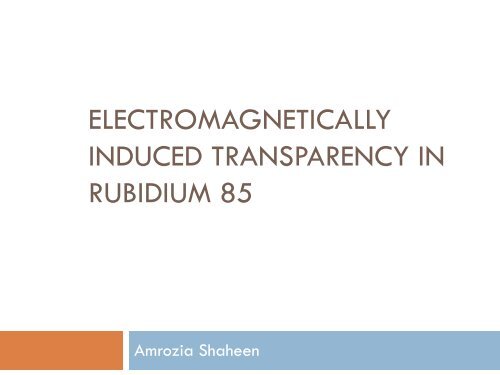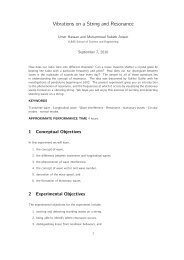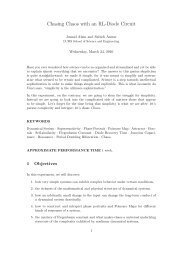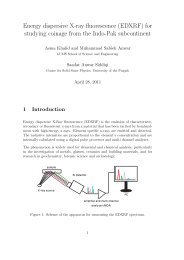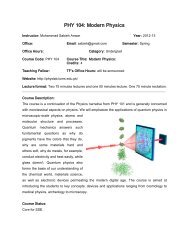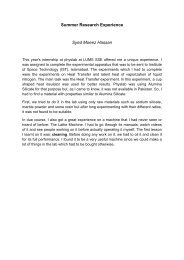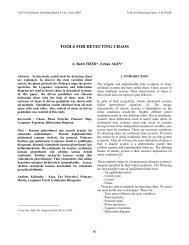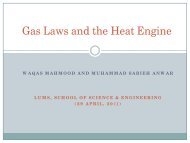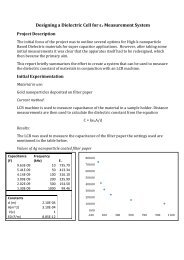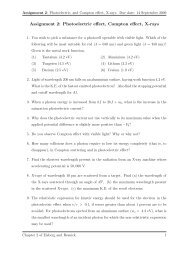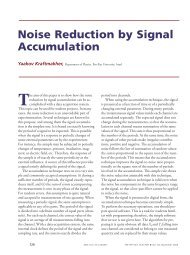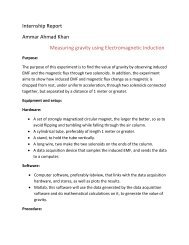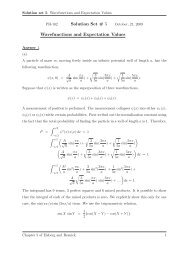Electromagnetically induced transparency
Electromagnetically induced transparency
Electromagnetically induced transparency
Create successful ePaper yourself
Turn your PDF publications into a flip-book with our unique Google optimized e-Paper software.
ELECTROMAGNETICALLYINDUCED TRANSPARENCY INRUBIDIUM 85Amrozia Shaheen
<strong>Electromagnetically</strong> <strong>induced</strong><strong>transparency</strong> The concept of EIT was first given by Harris et al in1990. When a strong coupling laser field is used todrive a resonant transition in a three-level atomicsystem, the absorption of a weak probe laser fieldcan be reduced or eliminated provided the tworesonant transitions are coherently coupled to acommon state. EIT was first observed in lambda type system ofstrontium vapors using high pulsed laser in 1991.
Stimulated absorption Stimulated Absorption: When a photon of energyequals to the energy difference between twoatomic levels interacts with the atom. The atom inthe lower energy state, absorbs the photon andjumps to the higher energy state (excited state).
Spontaneous emission Spontaneous emission: A process by which anatom in the excited state undergoes a transition tothe lower energy state (ground state) and emits aphoton.
Stimulated emission Stimulated emission: A process by which an atomicelectron (in excited state) interacts with anelectromagnetic wave drop to a lower energy leveltransferring its energy to that field
Rubidium 85 Rubidium is a silvery white metallic element alkalimetal group. Electronic configuration: Fine structure splitting:ForelectronGround state
Rubidium 85 First excited state:Possible states Second excited state:possible states
Rubidium 85 Hyper fine splitting: This is interaction of nuclearspin (I) with the electron angular momentum (J). HF splitting of ground state is, HF splitting of the 1 st and 2 nd excited states is,
Energy level diagram of 85 Rb
Three level Ladder type system Two laser beams are used to excite the electronictransitions. Probe beam for thetransition , couplingbeam for .probe beamdetuning whileis thecoupling beam detuning.
Ladder type system The initial state of the system is, The state of the system evolves after time t, so thetime dependent wave function is,
Hamiltonian The total Hamiltonian of the system can be find outusing perturbative approach, Unperturbed part:using orthonormality condition, i.e.,
Hamiltonian Perturbed part: When an electromagnetic fieldinteracts with the atom, the interaction Hamiltonianis,under parity conservation
Hamiltonian Total Hamiltonian:
Time evolution of the density matrix Using density matrix has its own significance as anin physical systems the exact state of the system ishardly known but only probabilities are known. The density operator is, The time evolution of the density matrix can be findout by Liouville (Von Neumann) equation,
Time evolution of the density matrix Generalized form of the density operatorequation of motion:and the density matrix elements are,
Time evolution of the density matrix
Time evolution of density matrixThe matrix elements are,
Time evolution of the density matrixinitial conditions are,substituting,
Time evolution of the density matrixNow the equation of motion becomes,Introducing the transformations,
Time evolution of the density matrixThese equations are of the form,Steady state solution can be obtained by solving,
Time evolution of the density matrixHere B is a matrix of cofactors.
Time evolution of the density matrixsimilarly,
Complex susceptibility The real and imaginary parts of the complexsusceptibilty are used to define the dispersion andabsorption coefficients, The complex susceptibility and polarization isrelated by, Atomic polarization for N number of atoms per unitvolume is,
Complex susceptibility Doppler broadening effects: The atom moving towardsthe probe beam will feel an up shift in its frequency byan amount and downshifted for the coupling beamby the factor . As number of atoms per unit volume is , andis of Maxwellian form,
Complex Susceptibilitysubstituting,
Complex susceptibility Ignoring two photon transition:
Complex susceptibility The error function is the integral of normalizedgaussian function,and the susceptibility is,
Complex susceptibility Including two photon transition:
Complex susceptibilityso two complex roots are,The integral can be written as,Mathematica gives,
Complex susceptibilitythe constants C 1 and C 2 are,where,Logarithm of any complex number is,and,
Complex susceptibilityDefining the function,where sgn is the signum function defined as,and the susceptibility expression becomes,
Results
Results
Applications of EIT Fundamental and commercial applications of EIT inatomic physics and quantum optics include, Lasing without inversion, Reduction of the speed of light, Quantum memory, Optical switches, All optical wavelength converters fortelecommunications, Quantum information processing.


